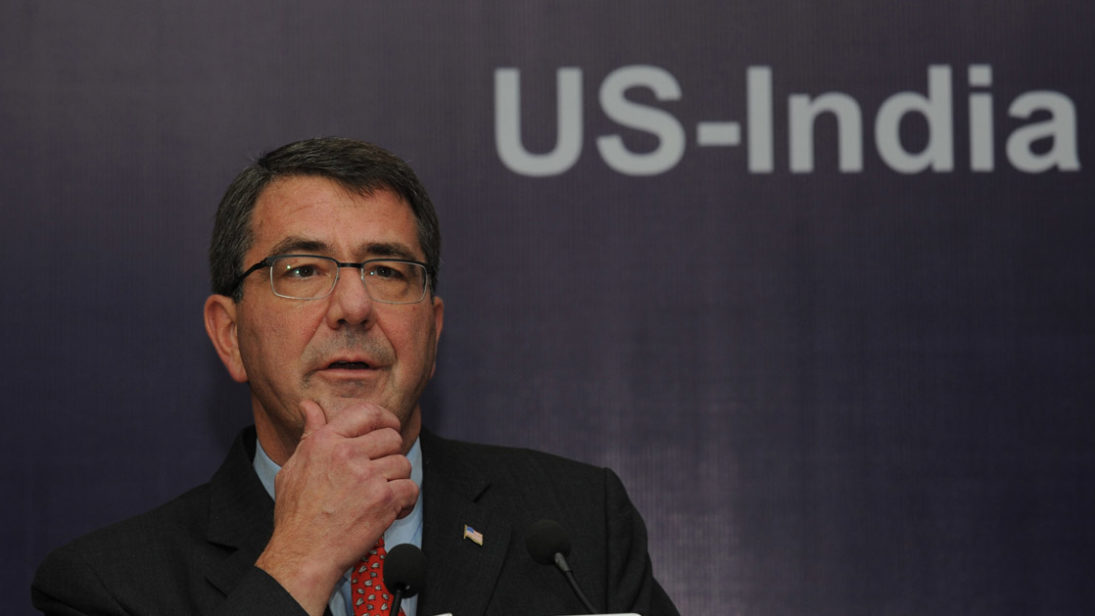
As U.S. Defense Secretary Ashton Carter kicks off his India visit today, he is looking to infuse greater strategic purpose in America’s bilateral defense relations with India. Defense ties have grown rapidly in the past decade, with the United States accounting for 14 percent of Indian defense imports in the period 2011-2015. However, failure of the United Progressive Alliance (UPA) government to follow through on the framework for defense cooperation, signed in 2005 to lay the foundation for a productive strategic partnership, stymied cooperation. In contrast, Prime Minister Narendra Modi has brought much greater enthusiasm and engagement to the relationship. Along with renewing the defense cooperation framework for 10 years, Modi under the Make in India program is determined to give a big boost to Indian indigenous defense industry through expanded cooperation with the United States. A similar intent to bolster India’s defense preparedness is visible in the United States, with the introduction of a bill in Congress aimed at formalizing India’s status as equivalent to America’s treaty allies. Thus, Secretary Carter’s visit comes at a time when the two countries are closer than ever, and aiming to cement their partnership even further through co-development of weapon systems, logistics and data-sharing agreements for military cooperation, and working together on maritime security in the Indo-Pacific.
Carter’s visit is expected to breathe new life into the Defense Technology and Trade Initiative (DTTI)—a mechanism to expedite defense trade and technology cooperation by overcoming bureaucratic hurdles. Under DTTI, both sides had identified four pathfinder projects, and Secretary Carter’s visit will see discussion on an additional 17 potential projects, of which a few may get finalized. Another key objective is to break the gridlock on foundational agreements—Logistics Support Agreement (LSA) on military cooperation, Communication Interoperability and Security Memorandum of Agreement (CISMOA) on transfer of technology, and the Basic Exchange and Cooperation Agreement (BECA) on sharing mapping data and imagery. While the UPA government was hesitant to sign on to these agreements, talks have progressed under Modi. Signing the LSA will allow Indian and U.S. ships and aircraft to refurbish and refuel from each other’s bases. However, India contends that instead of blanket permission to utilize every Indian facility, selective access can be provided to civilian facilities, with military facilities excluded. Another aspect that requires clarification is India’s obligation under wartime conditions. It seems highly likely that both sides would be able to resolve these outstanding issues and sign the LSA during the visit. However, CISMOA and BECA are still inchoate due to India’s concerns over giving the United States unrestricted access to encrypted systems and military bases.
Other strategic issues likely to be discussed include India’s disappointment over the U.S. sale of eight F-16s to Pakistan. As well-known Indian strategist C. Raja Mohan has noted, the sale of a few F-16s to Pakistan does not alter the balance of power in the region—India worries about “negative political consequences” of such sales, which only boost the Pakistan Army’s dominance without putting adequate pressure on them to crackdown on anti-India terrorist groups. Clearer understanding is also required from the United States on transfer of technology (ToT) issues with regard to the Make in India program. American defense manufacturers such as Boeing and Lockheed Martin are ready for unqualified ToT, while the Pentagon is likely to deny India certain key technologies without the foundational agreements in place. Also, despite several meetings to formulate a roadmap to co-develop and co-produce cutting-edge weapons systems, several analysts still remain skeptical about the feasibility of these advanced projects.
However, the United States and India will have some reason to celebrate as the deal to manufacture M-777 Howitzer guns in India is expected to come through with a Make in India component. At a recent event, Secretary Carter remarked that the United States is considering co-production of fighter aircraft with India, likely the much-touted, indigenous Advanced Medium Combat Aircraft (AMCA). Advancing bilateral cooperation on developing an electro-magnetic aircraft launch system (EMALS) is also being considered.
Of course, the rationale for stronger defense ties is the shifting balance of power in the Indo-Pacific region. There is a great degree of complementarity between India’s Act East and the United States’ rebalance strategy as both wish to see the Indo-Pacific as a multipolar region. Owing to the Chinese threat, both countries are increasingly involved in complex maritime exercises, reportedly with a focus on anti-submarine warfare, and have extended their bilateral Malabar exercise to include Japan. Amid possibilities of military confrontation due to Chinese assertiveness in the South China Sea, U.S. Pacific Commander Admiral Harry B Harris recently called on India to “conduct joint operations” in the South China Sea (SCS). While Indian officials were quick to dismiss the possibility of joint patrols in SCS, it is an idea which New Delhi might need to consider in the long run, as China continues its aggressive foray in the Indian Ocean with little consideration for India’s security concerns.
Both sides have demonstrated genuine efforts to provide substance and depth to defense relations. Whatever the outcome of Secretary Carter’s visit, Indians are acutely aware of his formidable reputation and nuanced understanding of India’s political sensitivities. At a recent event, he eloquently stated that Indians are a proud people and want to do things independently, such as improving their technical capabilities in defense by becoming co-developers and co-producers. The success of Secretary Carter’s visit, thus, will depend on New Delhi and Washington’s ability to find common ground to harmonize operational challenges with long-term security goals.
***
Image: Sajjad Hussain-AFP, Getty